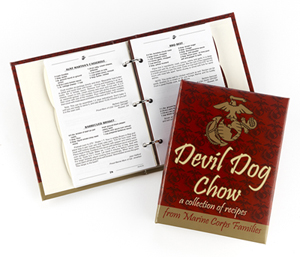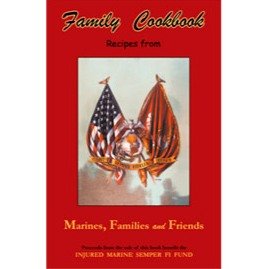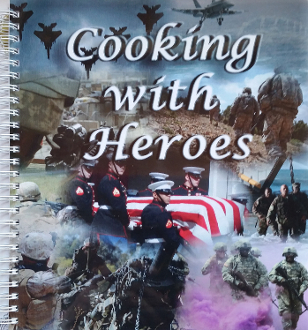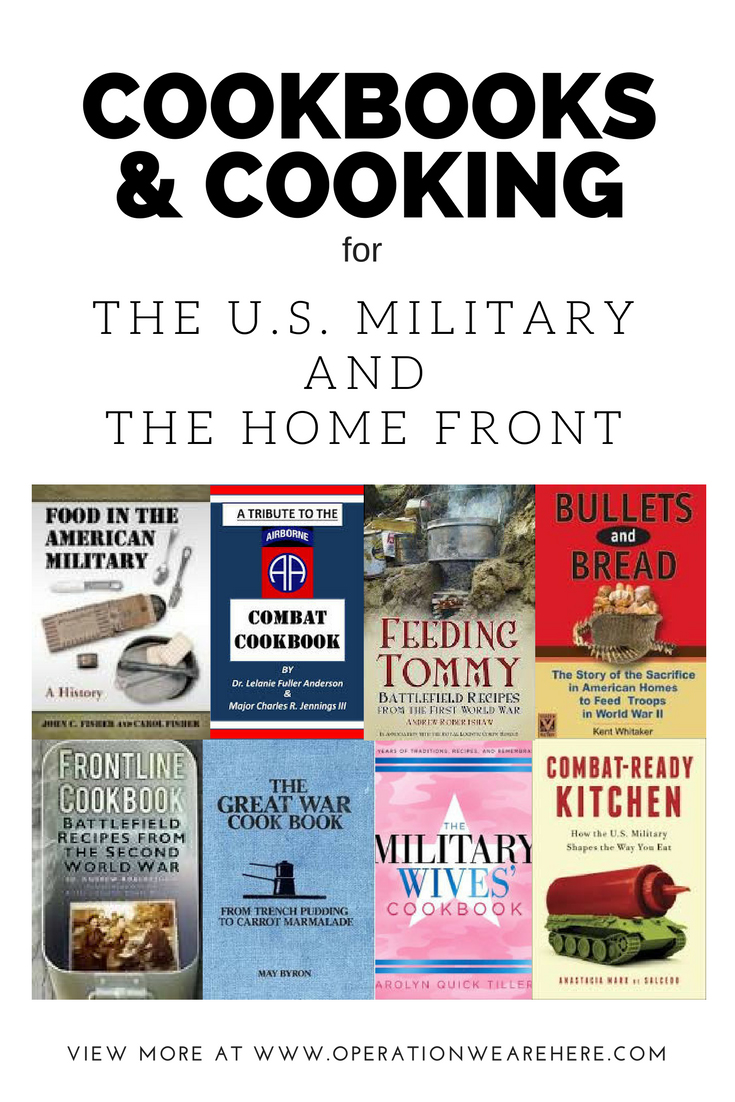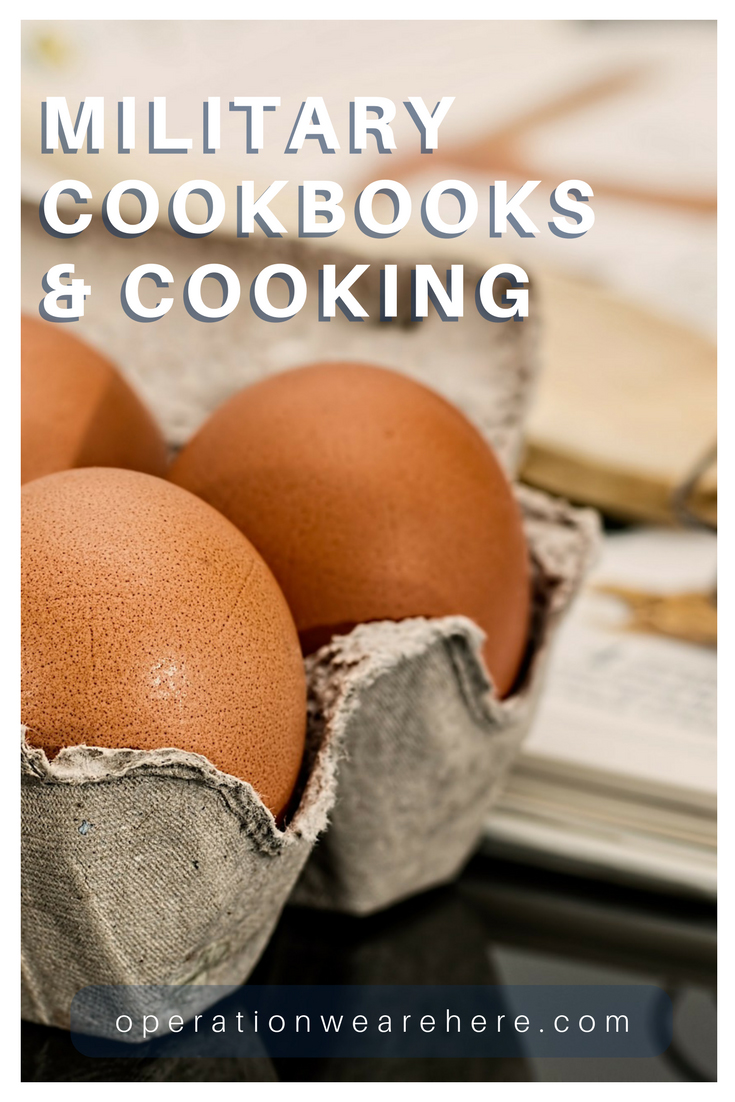A Tribute to the Airborne Combat Cookbook
Authors: Dr. Lelanie Fuller Anderson, Major Charles Ray Jenning, Copyright @ 2013
This book was conceived when my oldest son was in combat in Iraq in 2005. He was constantly in the field and eating MRE‘s (Meals ready to eat) on the run. My son would send requests for pots, pans, flour, yeast, and any foods that could survive the trip. I then had the thought to make up packages of different types of foods and menus. It contains food that can be shipped to your son or daughter in combat and made on the spot. Send them a "Taste" from Home.
Bullets and Bread
The story of the sacrifice in American homes to feed troops in WWII
Author: Kent Whitaker, Copyright @ 2013
The U.S. a collection of cities serviced by outlying farms and producers is amazingly transformed into a nation serviced, by a national food production industry to meet the needs of fighting a world war. The armed services, 350,000 strong at the war's start, quickly grew to 11,000,000 men and women who had to be fed along with the millions more on the home front. This is the story of the transformation to meet those needs and the interesting stories about the people, prominent and not-so prominent, of the era and the food they liked to eat and more frequently, what they had to eat. Many stories from the troops on the front are included and so too, many recipes suitable for today's dining.
Cooking on the Home Front
Favorite Recipes of the WWII years
Authors: Hugh and Judy Gowan, Copyright @ 1994
Victory gardens, ration books, meatless meals, or wartime shortages. The American women faced many challenges during the World War II years; here are some of the recipes that helped fight the war on the home front.
Chow
A cook's tour of military food
Author: Dickson, Copyright @ 1978
In these days, when refrigerators are full and KP is increasingly relegated to civilians, Uncle Sam provides amply, but until World War I military food was "terrible'. This 282 page agreeable history begins at Valley Forge, covers each of America's wartime provisions (up to Lurp in Vietnam), and includes today's cushier menus. Not every veteran will rush to whip up that infamous creamed beef, which properly begins the recipe section, or even bother with a slumgullion recipe which, feeding 100, requires, some adjustment for the family dinner table, but the others seem representative, tasty enough, and generally duplicable. Dickson also includes some official kitchen philosophy, surprisingly clearly phrased considering most military writing ("Remember that beans, badly boiled, kill more than bullets") and adds a few pointers on castaway cookery--eat what the monkeys eat and never drink sea water. And a glossary gathers in all those under-the-table locutions: "albatross" for chicken, "bug juice" for Kool-Aid, "braised trake" and "buttered ermal" for foolers. A mess to remember--not too spicy and a bit thin but warm enough and lightly processed.
Combat-Ready Kitchen
How the U.S. military shapes the way you eat
Author: Anastacia Marx de Salcedo, Copyright @ 2015
Americans eat more processed foods than anyone else in the world. We also spend more on military research. These two seemingly unrelated facts are inextricably linked. If you ever wondered how ready-to-eat foods infiltrated your kitchen, you’ll love this entertaining romp through the secret military history of practically everything you buy at the supermarket.
In a nondescript Boston suburb, in a handful of low buildings buffered by trees and a lake, a group of men and women spend their days researching, testing, tasting, and producing the foods that form the bedrock of the American diet. If you stumbled into the facility, you might think the technicians dressed in lab coats and the shiny kitchen equipment belonged to one of the giant food conglomerates responsible for your favorite brand of frozen pizza or microwavable breakfast burritos. So you’d be surprised to learn that you’ve just entered the U.S. Army Natick Soldier Systems Center, ground zero for the processed food industry.
Ever since Napoleon, armies have sought better ways to preserve, store, and transport food for battle. As part of this quest, although most people don’t realize it, the U.S. military spearheaded the invention of energy bars, restructured meat, extended-life bread, instant coffee, and much more. But there’s been an insidious mission creep: because the military enlisted industry—huge corporations such as ADM, ConAgra, General Mills, Hershey, Hormel, Mars, Nabisco, Reynolds, Smithfield, Swift, Tyson, and Unilever—to help develop and manufacture food for soldiers on the front line, over the years combat rations, or the key technologies used in engineering them, have ended up dominating grocery store shelves and refrigerator cases. TV dinners, the cheese powder in snack foods, cling wrap . . . The list is almost endless.
Now food writer Anastacia Marx de Salcedo scrutinizes the world of processed food and its long relationship with the military—unveiling the twists, turns, successes, failures, and products that have found their way from the armed forces’ and contractors’ laboratories into our kitchens. In developing these rations, the army was looking for some of the very same qualities as we do in our hectic, fast-paced twenty-first-century lives: portability, ease of preparation, extended shelf life at room temperature, affordability, and appeal to even the least adventurous eaters. In other words, the military has us chowing down like special ops.
What is the effect of such a diet, eaten—as it is by soldiers and most consumers—day in and day out, year after year? We don’t really know. We’re the guinea pigs in a giant public health experiment, one in which science and technology, at the beck and call of the military, have taken over our kitchens.
Cooking with Heroes
A collection of recipes by United States Military Service members with special color pages recognizing some of our fallen heroes.
Recipes were submitted by friends & family, active & retired veterans from WWII, Korean Conflict, Vietnam War, Operation Enduring Freedom and Operation Iraqi Freedom.
Devil Dog Chow Cookbook
A collection of recipes from Marine Corps families
From Marine Corps families
Devil Dog Chow™ is an amazing collection of recipes and inspiration. Families and friends from around the United States have contributed the favorite recipes of our Marines and recruits, honoring them in our own small way. Our love for our Marines and recruits can be found throughout this cookbook as it is found in our everyday lives.
The finely illustrated and professionally finished 3-ring binder cookbook is a perfect addition to any collection of cookbooks or Marine Corps memorabilia. The laminated cover will assure years of use and show beautifully in any collection.
The Marines and the Marine Corps way inspires us to be better people. With that thought in mind, we have included inspirational quotes mixed throughout the recipes in this unique cookbook. The quotes from famous people, Marines, moms and dads and even a child of a Marine all stem from the enormous amount of pride we have in our Marines, who so heroically serve our country and defend our freedom.
Everyday Foods in Wartime
War time recipes (Foods eaten during the First World War on the homefront)
Author: Mary Swartz Rose, Copyright @ 2015
Wartime Recipes. “FOOD IS FUEL FOR FIGHTERS. Do not waste it. Save WHEAT, MEAT, SUGARS AND FATS. Send more to our Soldiers, Sailors and Allies.” The patriotic housewife finds her little domestic boat sailing in uncharted waters. The above message of the Food Administration disturbs her ordinary household routine, upsets her menus and puts her recipes out of commission. It also renders inoperative some of her usual methods of economy at a time when rising food prices make economy more imperative than ever. To be patriotic and still live on one’s income is a complex problem. This little book was started in response to a request for “a war message about food.” It seemed to the author that a simple explanation of the part which some of our common foods play in our diet might be both helpful and reassuring. To change one’s menu is often trying; to be uncertain whether the substituted foods will preserve one’s health and strength makes adjustment doubly difficult. It is hoped that the brief chapters which follow will make it easier to “save wheat, meat, sugars and fats” and to make out an acceptable bill of fare without excessive cost. Thanks are due to the Webb Publishing Company, St. Paul, Minnesota, for permission to reprint three of the chapters, which appeared originally in The Farmer’s Wife.
Family Cookbook
Recipes from Marines, families and friends
This cookbook was created by Marines’ families, as well as members of other arms of our military and troop supporters. All proceeds from the sales of the cookbook will benefit the Injured Marine Semper Fi Fund.
Our long time supporter and friend of the Semper Fi Fund, Gladys Rodriguez has solicited recipes to create the first Family Cookbook – Recipes from Marines, Families and Friends. The following is a description written within the cookbook:
“This cookbook was created by Marines’ families, as well as members of other arms of our military and troop supporters. It started with an informal conversation regarding other ways to raise money, and it quickly became a project that brought together a very giving and close community. From the proud parents of Marine recruits, to family members of high-ranking officials of the Marine Corps and other arms of the military, and just plain citizens who wanted to help, the recipes started pouring in.
We are confident that with the help of the many generous and patriotic individuals who truly appreciate the sacrifices that these young men and women are making, the funds raised from the sale of this cookbook will be a constant source of help to our injured warriors and their families.
We hope that as you enjoy the recipes, you will take a moment to think about our troops and will choose to get involved in assisting with this fundraiser. Every individual has the power to help. Talk to your family and friends about it and spread the word – it’s as simple as that. We do the rest. “
Feeding Tommy
Battlefield recipes from the First World War
Author: Andrew Robertshaw, Copyright @ 2013
According to Napoleon, an army marches on its stomach and it fights on its stomach too. Yet, have you ever wondered how hundreds of men on the frontline are fed under fire or in the trench lines? During the Great War troops were trained to make meals out of the bare minimum of ingredients, to feed a company of men from only a mess tin and cook curries to feed hundreds only yards from the frontline. Feeding Tommy brings together recipes from the WWI with hints and tips from the Tommy Cook. Many recipes are illustrated with cartoons and drawings on how to assemble the perfect oven and kitchen tools at a moment’s notice from nothing. This book is the perfect inspiration for those who like to create an amazing meal anywhere, anytime, from anything. Includes dual measurements.
Food in the American Military
A history
Authors: John C. Fisher and Carol Fisher, Copyright @ 2010
American military food programs have progressed from simple campfire cooking to today's nutritionally sound, menu diverse, high tech, and ethnically correct feeding options. This book describes the historical development of rations used by America's military from the Revolutionary War to the present, recounting challenges and opportunities faced by war planners in obtaining and transporting food to soldiers, sailors, and marines. It discusses ration research and development, the evolution of food personnel training, and the various methods of food storage, preparation, and distribution. In addition, numerous first-person accounts document the military's efforts to supplement regular rations through foraging activities and by using local food sources. Finally, the book demonstrates how food is necessary not only for health and sustenance, but also as a vital morale builder.
Frontline Cookbook
Battlefield recipes from the Second World War
Author: Andy Robertshaw, Copyright @ 2012
According to Napoleon, an army marches on its stomach and it fights on its stomach too - yet have you ever wondered how hundreds of men on the frontline are fed amidst hails of bullets and how kitchens are created in the desert or in the trench lines? In 1941 the Army officially created the Army Catering Corps and opened the Army School of Cookery in Aldershot. Troops were trained to make meals out of the bare minimum of ingredients, to feed a company of men from only a mess tin and cook curries to feed hundreds only yards from the frontline. Frontline Cooking brings together recipes from the Second World War, including hand-written notes from troops fighting in the Middle East, India and all over Europe. Many recipes are illustrated with cartoons and drawings on how to assemble the perfect oven and kitchen tools at a moment's notice from nothing. This book is the perfect inspiration for those who like to create an amazing meal anywhere, anytime, from anything.
How to Feed an Army
Recipes and lore from the front lines
Authors: Jim Lewin, P.J. Huff, Copyright @ 2006
For more than 200 years, the American military has been doing its best to figure out How to Feed an Army. What they've managed to concoct along the way is a rich history of culinary successes, and some rather interesting side trips into the realm of experimentation. This is part cookbook and part history, and a full measure of fun. Inside you will find:
- More than 125 authentic military recipes from the American Revolution through Operation Iraqi Freedom
- How a fish fry ended the Civil War
- The best method for baking bread (it begins with a shovel)
- How to determine an oven's temperature without using a thermometer
- Recipes you can try at home, including Caribbean Catfish, hard tack, and English muffin french toast.
You will want to read this book if you have an interest in cooking. Or in eating. Or in history. Or in the military's version of any of the above.
The Great War Cookbook
From Trench Pudding to Carrot Marmalade
Author: May Byron, Copyright @ 2014
First published in 1915, May Byron’s Wartime Cookery Book soon became a classic of wartime Home Front cook books. With some 550 recipes, she showed how to make tasty meals from basic, readily available and homegrown products.
With unrestricted submarine warfare and the loss of so many ships in the war, the populations of both Britain and Germany were nearly starved into submission. Food writer May Byron gives us a flavor of life on the Home Front with her Wartime Cookery Book, showing the everyday woman how to put a meal on the table with a reduced selection of ingredients.
From pigs’ trotters to raspberry and beetroot jam, she produced tasty recipes that could keep everyone fed using produce sourced mainly from Britain’s field, hedgerows and woodlands.
The Military Wives' Cookbook
200 years of traditions, recipes, and remembrances
Author: Carolyn Quick Tillery, Copyright @ 2008
The Military Wives' Cookbook is a collection of recipes, anecdotal stories, and vintage photographs tracing the history and unique contributions of American military wives. Beginning with an Independence Tea Party featuring the foods served by the women of Edenton, North Carolina, at a party on October 25, 1774, it recreates the scenes and foods that recount the stories of the commitments and sacrifice that military wives have given the nation for more than two hundred years.
Presented in menu format, each chapter includes a story that relates to a group of recipes evocative of the period in which the story is set. Some chapters recreate recipes from a historic account, such as "A Colonial Thanksgiving" and "Christmas in the Confederate White House," both of which describe holidays celebrated under wartime conditions. Others are of the international foods they have learned to enjoy from such places as Morocco, Italy, Spain, France, Germany, Japan, and Korea. The book is divided into six large sections: Teas and Coffees; Buffets, Brunches, and Lunches; A Taste of Home: Dinner Family Style; Alfresco Dining; Over There: An International Affair; Home for the Holidays and Other Celebrations.
The women, through whose eyes these stories are told and whose recipes are shared, are truly remarkable. They often balanced the responsibilities of maintaining home and hearth, raising a family, managing a business, and supporting a war effort. In addition, they found time to extend themselves in friendship and hospitality to one another and to women in the places where they were stationed, earning them a well-respected reputation that continues to this day.
The Warrior's Table
Recipes that cultivate connection through war, change, and uncertainty
Author: The Cast Iron Crew, Copyright @ 2023
The Warrior's Table tells the story of life in the Special Operations Forces (SOF) community through the experiences of real SOF spouses and families across the service branches.
Our family dinner team, The Cast Iron Crew, shares recipes from decades in SOF and how they safeguard what matters most. This unique cookbook is more than just that--it's a book of delicious recipes and a guide to connecting and thriving in this demanding lifestyle.
Living intentionally in special operations is incredibly hard. It's easy to let "common pitfalls" slip in and break down simple habits needed to endure and overcome challenges that inevitably arise. Mealtime can be a family and community ritual that reinforces routines and habits to counter those pitfalls, because shared mealtime is not about being tied to an oven or the dinner table it's about fundamentally caring for the minds, bodies, and hearts of those in your life. Mealtimes are ultimately about building belonging to a family, a community, and lifestyle.
In addition to the book highlighting history, culture, and family life strategies, The Warrior's Table covers what it is like to live life as a special operations family from unit selection to well past a family's time of service. In the ten chapters and many sections within, we story-tell of universal SOF experiences.
Copyright 2008 - 2023 Benita Koeman, Operation We Are Here. All rights reserved.
Operation We Are Here is a HUB of RESOURCES for the military community and military supporters.
Military support is not a concept to embrace; military support is sacrificial action. Visit our military support TOOLKIT.
Military cookbooks & cooking
Disclosure: Benita Koeman of Operation We Are Here is a participant in the Amazon Services LLC Associates Program, an affiliate advertising program designed to provide a means for sites to earn advertising fees by advertising and linking to Amazon.com. When you purchase a product that is linked to Amazon, I earn a small commission which in turn helps me to continue with my mission of providing resources to the military community and military supporters. Learn more...
Return to Books for the Military Community & Supporters - LINK
Military cookbooks
Resources for supporters of military and veteran families
- Practical insights in caring for
Military and veteran family resources
- Christian encouragement
- Deployment support for
- Downloads and printables
Operation We Are Here
Follow us on
resources

